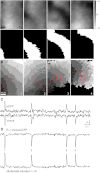Extrasynaptic glutamate and inhibitory neurotransmission modulate ganglion cell participation during glutamatergic retinal waves
- PMID: 23343894
- PMCID: PMC3628007
- DOI: 10.1152/jn.00039.2013
Extrasynaptic glutamate and inhibitory neurotransmission modulate ganglion cell participation during glutamatergic retinal waves
Abstract
During the first 2 wk of mouse postnatal development, transient retinal circuits give rise to the spontaneous initiation and lateral propagation of depolarizations across the ganglion cell layer (GCL). Glutamatergic retinal waves occur during the second postnatal week, when GCL depolarizations are mediated by ionotropic glutamate receptors. Bipolar cells are the primary source of glutamate in the inner retina, indicating that the propagation of waves depends on their activation. Using the fluorescence resonance energy transfer-based optical sensor of glutamate FLII81E-1μ, we found that retinal waves are accompanied by a large transient increase in extrasynaptic glutamate throughout the inner plexiform layer. Using two-photon Ca(2+) imaging to record spontaneous Ca(2+) transients in large populations of cells, we found that despite this spatially diffuse source of depolarization, only a subset of neurons in the GCL and inner nuclear layer (INL) are robustly depolarized during retinal waves. Application of the glutamate transporter blocker dl-threo-β-benzyloxyaspartate (25 μM) led to a significant increase in cell participation in both layers, indicating that the concentration of extrasynaptic glutamate affects cell participation in both the INL and GCL. In contrast, blocking inhibitory transmission with the GABAA receptor antagonist gabazine and the glycine receptor antagonist strychnine increased cell participation in the GCL without significantly affecting the INL. These data indicate that during development, glutamate spillover provides a spatially diffuse source of depolarization, but that inhibitory circuits dictate which neurons within the GCL participate in retinal waves.
Figures






Similar articles
-
Synaptic and extrasynaptic factors governing glutamatergic retinal waves.Neuron. 2009 Apr 30;62(2):230-41. doi: 10.1016/j.neuron.2009.03.015. Neuron. 2009. PMID: 19409268 Free PMC article.
-
Excitatory synaptic inputs to mouse on-off direction-selective retinal ganglion cells lack direction tuning.J Neurosci. 2014 Mar 12;34(11):3976-81. doi: 10.1523/JNEUROSCI.5017-13.2014. J Neurosci. 2014. PMID: 24623775 Free PMC article.
-
Potentiation of L-type calcium channels reveals nonsynaptic mechanisms that correlate spontaneous activity in the developing mammalian retina.J Neurosci. 2001 Nov 1;21(21):8514-22. doi: 10.1523/JNEUROSCI.21-21-08514.2001. J Neurosci. 2001. PMID: 11606640 Free PMC article.
-
Mechanisms of glycine release, which build up synaptic and extrasynaptic glycine levels: the role of synaptic and non-synaptic glycine transporters.Brain Res Bull. 2013 Apr;93:110-9. doi: 10.1016/j.brainresbull.2012.12.002. Epub 2012 Dec 22. Brain Res Bull. 2013. PMID: 23266673 Review.
-
[The post-synaptic glycine receptor mediates in a transitory and sustained way the glycinergic inhibition in the vertebrate retina].Rev Neurol. 2012 Jul 1;55(1):38-46. Rev Neurol. 2012. PMID: 22718408 Review. Spanish.
Cited by
-
Stereotyped initiation of retinal waves by bipolar cells via presynaptic NMDA autoreceptors.Nat Commun. 2016 Sep 2;7:12650. doi: 10.1038/ncomms12650. Nat Commun. 2016. PMID: 27586999 Free PMC article.
-
The Interplay between Neurotransmitters and Calcium Dynamics in Retinal Synapses during Development, Health, and Disease.Int J Mol Sci. 2024 Feb 13;25(4):2226. doi: 10.3390/ijms25042226. Int J Mol Sci. 2024. PMID: 38396913 Free PMC article. Review.
-
Neuron-glia signaling in developing retina mediated by neurotransmitter spillover.Elife. 2015 Aug 14;4:e09590. doi: 10.7554/eLife.09590. Elife. 2015. PMID: 26274565 Free PMC article.
-
Müller Glial Cells Participate in Retinal Waves via Glutamate Transporters and AMPA Receptors.Cell Rep. 2019 Jun 4;27(10):2871-2880.e2. doi: 10.1016/j.celrep.2019.05.011. Cell Rep. 2019. PMID: 31167134 Free PMC article.
-
Increasing Spontaneous Retinal Activity before Eye Opening Accelerates the Development of Geniculate Receptive Fields.J Neurosci. 2015 Oct 28;35(43):14612-23. doi: 10.1523/JNEUROSCI.1365-15.2015. J Neurosci. 2015. PMID: 26511250 Free PMC article.
References
-
- Bansal A, Singer JH, Hwang BJ, Xu W, Beaudet A, Feller MB. Mice lacking specific nicotinic acetylcholine receptor subunits exhibit dramatically altered spontaneous activity patterns, and reveal a limited role for retinal waves in forming O.N and OFF circuits in the inner retina. J Neurosci 20: 7672–7681, 2000 - PMC - PubMed
Publication types
MeSH terms
Substances
Grants and funding
LinkOut - more resources
Full Text Sources
Other Literature Sources
Miscellaneous

